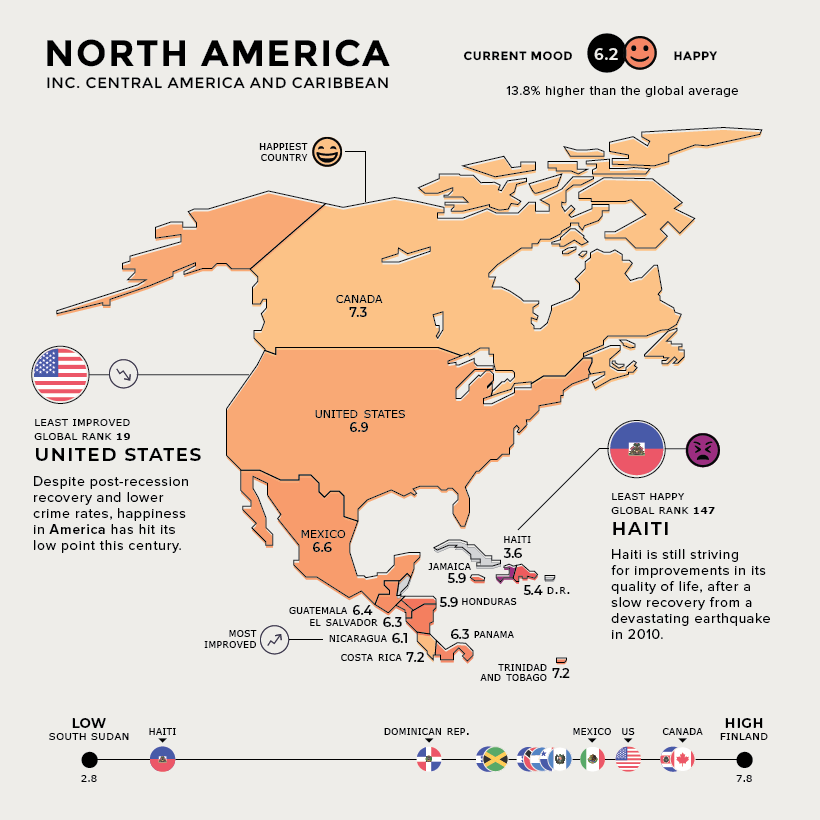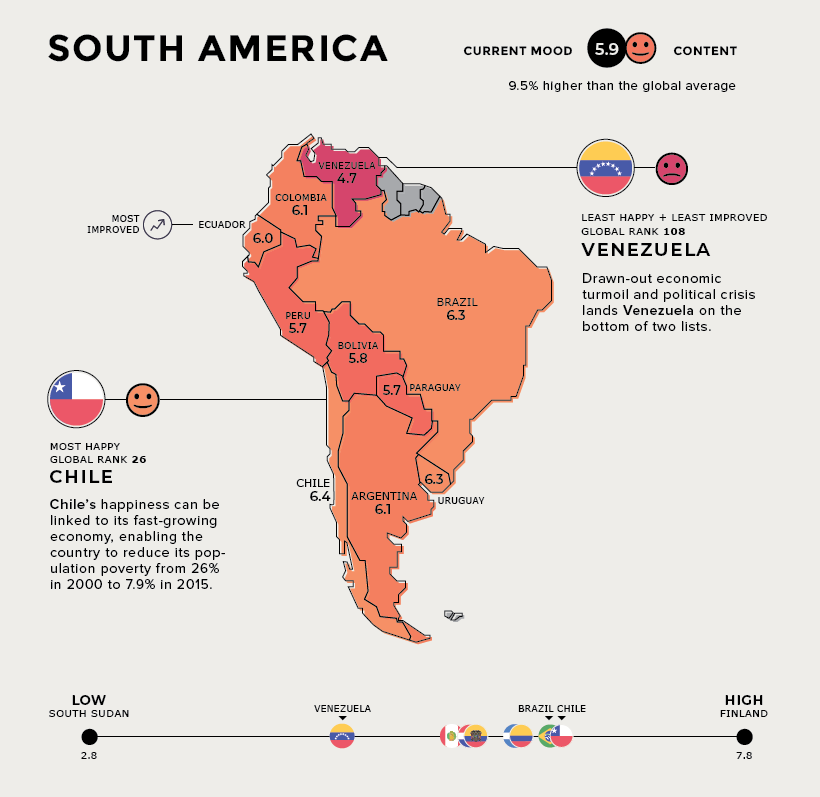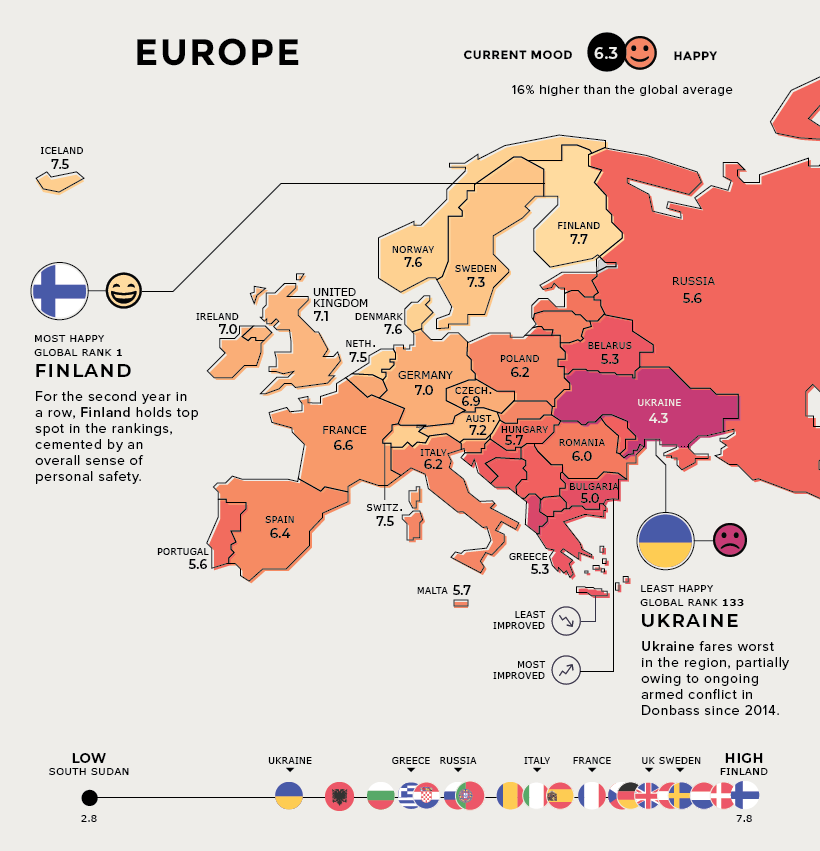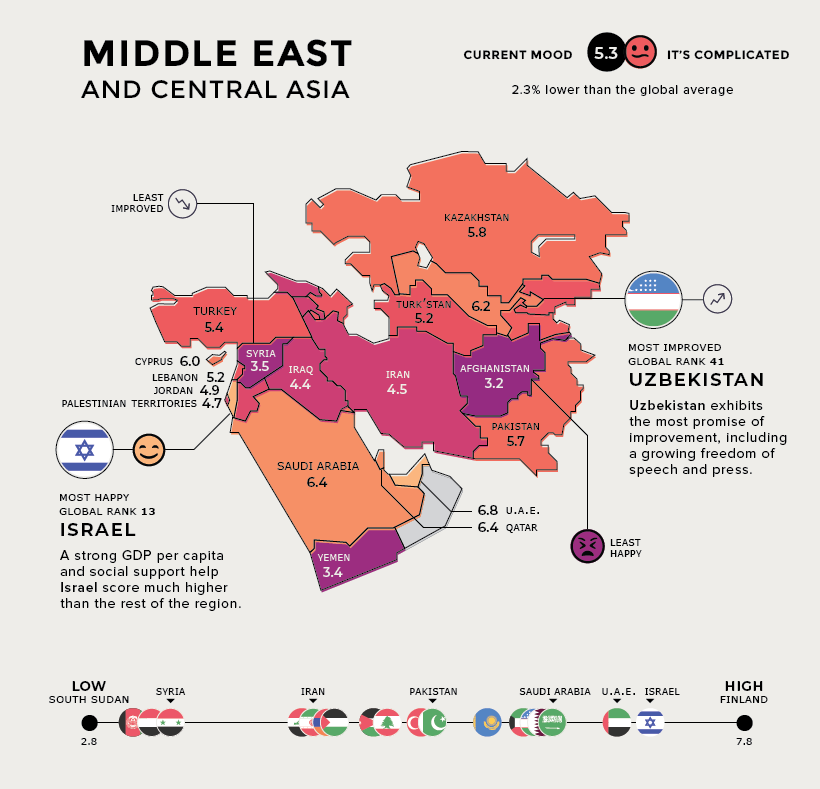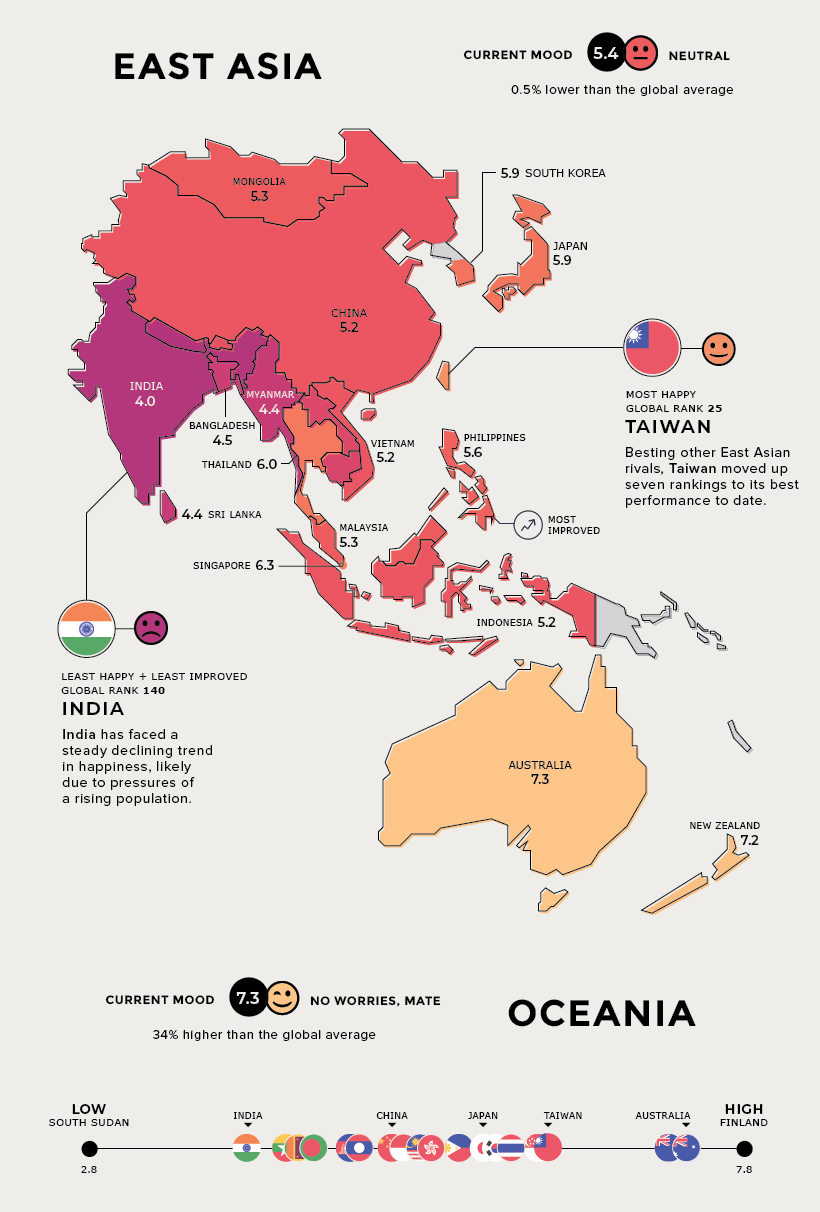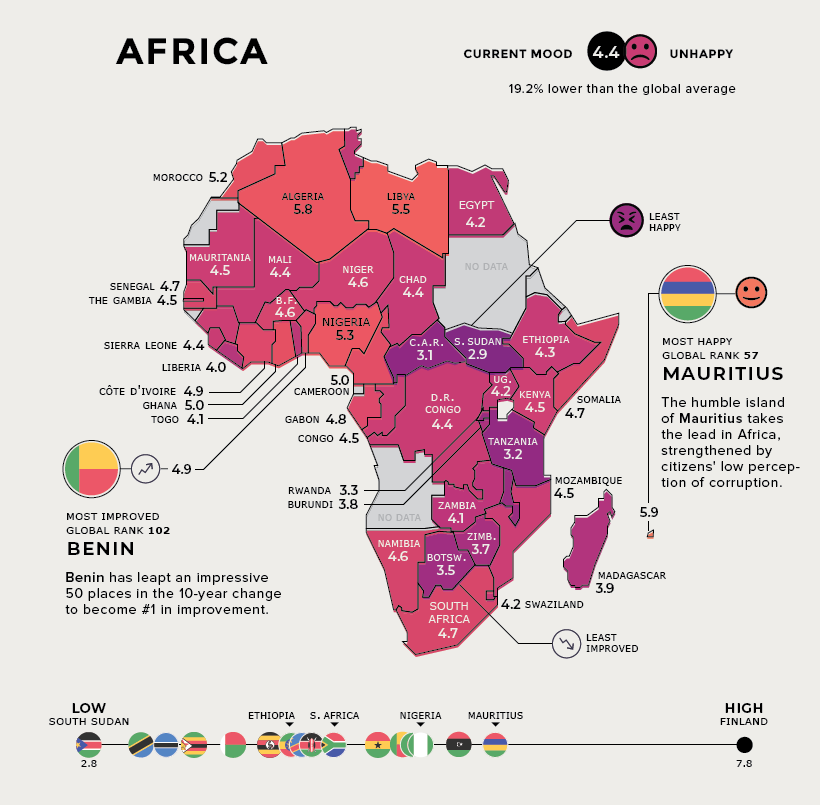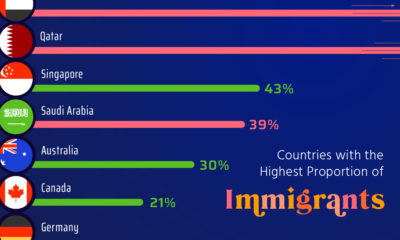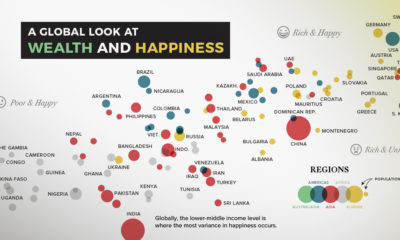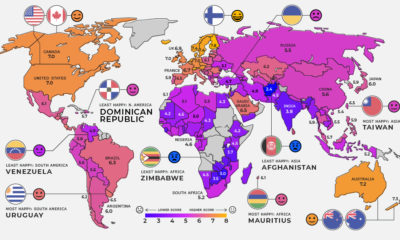Today’s visualization pulls data from the seventh World Happiness Report 2019, which ranks 156 countries by their happiness levels. We’ve previously shown the variables used to measure happiness in this report, but here, we break down rankings by continent and region for a clearer picture of where each country lies.
North America
Unhappy Americans have caused the country to tumble in rankings for a third straight year, despite evidence that things are generally looking up. The report attributes much of this erosion to a variety of addictions: opioids, workaholism, gambling, internet, exercise, and even shopping are among them. Haiti is the least happy country in this region. The country is still struggling to rebuild sanitation infrastructure and other educational and healthcare programs, despite foreign aid. In brighter news, Nicaragua is seeing great gains in happiness levels, as the country makes a concentrated effort to reduce poverty.
South America
In South America, the majority of countries cluster around a score of six on the happiness scale. The one notable exception to this is Venezuela, which is faltering in both happiness rank and regional improvement. The nation’s hyperinflation and humanitarian crisis both show no signs of slowing down.
Europe
Finland comes out on top of the world for a second consecutive year, and it’s not difficult to see why. The country boasts a stable work-life balance, bolstered by a comprehensive welfare state. Scandinavian countries appear among the happiest nations for similar very reasons — elevating the region’s score to 16% above the global average. On the flip side, Ukraine is the unhappiest, likely intensified by the ongoing war in southeastern Donbass. Greece is the least improved, as it continues to heal from the sovereign debt crisis.
Middle East and Central Asia
Uzbekistan shows the swiftest regional improvement, as the country has launched an ambitious reform agenda for greater economic, social, and political development and openness. Unfortunately, Syria’s continued civil war comes with a heavy price for its people and economy, as does the Palestinian-Israeli conflict — although the latter doesn’t seem to impact Israel’s happiness ranking. In fact, Israel finished with the 13th best score, globally.
Rest of Asia and Oceania
In East Asia, the average happiness score is quite close to the global average, with Taiwan standing out as the happiest country. Singapore out-competes other countries within Southeast Asia, despite only being home to a population of 5.6 million. Its neighbor Malaysia, however, plunged from 35th to 80th place. Oceania stands alone – Australia and New Zealand are closely matched in their individual happiness scores.
Africa
The African continent as a whole fares 19.2% below the global average. But there are silver linings, with strong strides towards improvement being made. Mauritius benefits from good governance and a buoyant tourism sector — with visitor arrivals equal to the island’s 1.3 million population. Meanwhile, Benin has soared in the rankings, and is supported by the World Bank in key structural reforms such as poverty reduction and access to basic services. What could these rankings look like in another ten years? Notes: The Africa map was updated to show more country scores. The report only covers 156 countries, so “Oceania” only refers to Australia and New Zealand in this instance. on Even while political regimes across these countries have changed over time, they’ve largely followed a few different types of governance. Today, every country can ultimately be classified into just nine broad forms of government systems. This map by Truman Du uses information from Wikipedia to map the government systems that rule the world today.
Countries By Type of Government
It’s important to note that this map charts government systems according to each country’s legal framework. Many countries have constitutions stating their de jure or legally recognized system of government, but their de facto or realized form of governance may be quite different. Here is a list of the stated government system of UN member states and observers as of January 2023: Let’s take a closer look at some of these systems.
Monarchies
Brought back into the spotlight after the death of Queen Elizabeth II of England in September 2022, this form of government has a single ruler. They carry titles from king and queen to sultan or emperor, and their government systems can be further divided into three modern types: constitutional, semi-constitutional, and absolute. A constitutional monarchy sees the monarch act as head of state within the parameters of a constitution, giving them little to no real power. For example, King Charles III is the head of 15 Commonwealth nations including Canada and Australia. However, each has their own head of government. On the other hand, a semi-constitutional monarchy lets the monarch or ruling royal family retain substantial political powers, as is the case in Jordan and Morocco. However, their monarchs still rule the country according to a democratic constitution and in concert with other institutions. Finally, an absolute monarchy is most like the monarchies of old, where the ruler has full power over governance, with modern examples including Saudi Arabia and Vatican City.
Republics
Unlike monarchies, the people hold the power in a republic government system, directly electing representatives to form government. Again, there are multiple types of modern republic governments: presidential, semi-presidential, and parliamentary. The presidential republic could be considered a direct progression from monarchies. This system has a strong and independent chief executive with extensive powers when it comes to domestic affairs and foreign policy. An example of this is the United States, where the President is both the head of state and the head of government. In a semi-presidential republic, the president is the head of state and has some executive powers that are independent of the legislature. However, the prime minister (or chancellor or equivalent title) is the head of government, responsible to the legislature along with the cabinet. Russia is a classic example of this type of government. The last type of republic system is parliamentary. In this system, the president is a figurehead, while the head of government holds real power and is validated by and accountable to the parliament. This type of system can be seen in Germany, Italy, and India and is akin to constitutional monarchies. It’s also important to point out that some parliamentary republic systems operate slightly differently. For example in South Africa, the president is both the head of state and government, but is elected directly by the legislature. This leaves them (and their ministries) potentially subject to parliamentary confidence.
One-Party State
Many of the systems above involve multiple political parties vying to rule and govern their respective countries. In a one-party state, also called a single-party state or single-party system, only one political party has the right to form government. All other political parties are either outlawed or only allowed limited participation in elections. In this system, a country’s head of state and head of government can be executive or ceremonial but political power is constitutionally linked to a single political movement. China is the most well-known example of this government system, with the General Secretary of the Communist Party of China ruling as the de facto leader since 1989.
Provisional
The final form of government is a provisional government formed as an interim or transitional government. In this system, an emergency governmental body is created to manage political transitions after the collapse of a government, or when a new state is formed. Often these evolve into fully constitutionalized systems, but sometimes they hold power for longer than expected. Some examples of countries that are considered provisional include Libya, Burkina Faso, and Chad.
